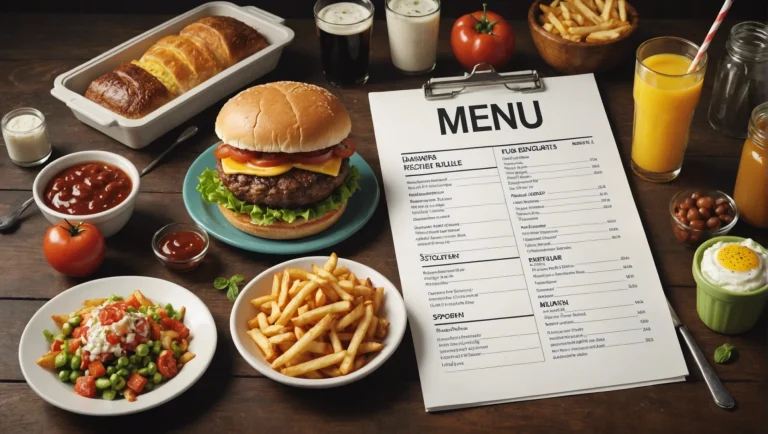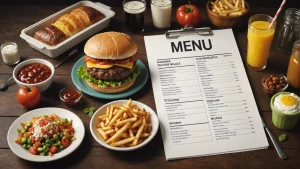In 2024, dining out comes with a side of transparency, thanks to the FDA Menu Labeling Rule.
The menu labeling regulations require restaurant chains with 20 or more locations with the same name to provide calorie content on menus, menu boards, and other point-of-sale materials and make other nutrition information available in writing on request.
No more guesswork or hidden calories.
With the FDA Menu Labeling Rule, you can make informed decisions about what you eat, empowering you to take control of your health when dining out.
In this comprehensive guide, we’ll break down everything you need to know about the rule, from the establishments covered to the law, specific labeling rules, requirements, and compliance guidelines.
Let’s dive in and explore how this rule is revolutionizing the way we eat in 2024.

27% higher customer satisfaction
Professional delivery features:
- Real-time GPS tracking
- Automated ETA updates
- Delivery confirmation photos
- 27% higher delivery satisfaction
What is the FDA Menu Labeling Regulations?
The FDA Menu Labeling Rule requires certain food establishments to provide calorie and nutrition information for standard menu items. Restaurants, fast-food chains, movie theaters, and vending machines with 20 or more locations must comply. Calorie counts, additional nutrition information, and a statement about daily calorie intake must be displayed on menus and menu boards. This game-changing regulation aims to provide consumers with clear and consistent nutrition information about the foods they eat away from home.
Wealthy Areas are More Likely to Face Calorie Labeling:
Restaurants in higher-income census tracts have 55% higher odds of being affected by the menu labeling rule compared to restaurants in lower-income tracts.
The FDA Menu Labeling Rule, which took effect on May 7, 2018, is one part of a chain of federal regulations that aims to provide consumers with clear and consistent nutrition information about the foods they eat away from home. This rule applies to restaurants and similar retail food establishments that are part of a chain with 20 or more locations, doing business under the same name, and offering substantially the same menu items. Master the fundamentals of restaurant food safety regulations to ensure compliance with the FDA Menu Labeling Rule and promote consumer trust in your establishment’s commitment to health and safety.
Establishments covered by the rule
The FDA Menu Labeling Rule covers a wide range of food establishments, including:
1. Restaurants and fast-food chains
2. Bakeries, coffee shops, and ice cream parlors
3. Cafeterias and delicatessens
4. Movie theaters and amusement parks
5. Vending machines operated by a person who owns or operates 20 or more machines
These establishments must provide calorie and nutrition information for standard menu items, which are defined as foods and beverages that are routinely included on a menu or menu board or routinely offered as self-service foods or foods on display.
Exemptions and special cases
Some establishments and menu items are exempt from the FDA Menu Labeling Rule, such covered establishments such as:
Temporary menu items offered for less than 60 days
Condiments and other items placed on the table for general use
Custom orders or items for sale that are not listed on the menu or menu board
Additionally, certain alcoholic beverages, such as those served at a bar or cocktail lounge, are exempt from the calorie labeling requirements. However, if alcoholic beverages are listed on the main menu or menu board, they must include calorie information. Understanding the regulations for a liquor permit? Discover the specifics of obtaining a liquor license, including which drinks might be exempt from calorie labeling requirements.
Information required on menus and menu boards
Under the FDA Menu Labeling Rule, covered establishments must provide the following information on their menus and menu boards:
1. Calorie counts for standard menu items: The calorie information must be clearly and prominently displayed next to the name or price of the menu item.
2. Additional nutrition information: Establishments must provide written nutrition information upon request, which includes total calories, total fat, saturated fat, trans fat, cholesterol, sodium, total carbohydrates, sugars, fiber, and protein.
3. Statement about daily calorie intake: Menus and menu boards must include a statement that puts the calorie information in the context of a total daily diet, such as “2,000 calories a day is used for general nutrition advice, but calorie needs vary.”
Displaying calorie information
Calorie information must be displayed clearly and conspicuously, using a font size and color that is easily readable. For menus and menu boards, the calorie count must be listed next to the name or price of the menu item, in a type size no smaller than the name or price (whichever is smaller).
For self-service foods and foods on display, calorie information must be posted on a sign adjacent to and clearly associated with the food item. This information can be provided per serving or per item, depending on how the food is displayed and sold.
Compliance and enforcement
The FDA is responsible for enforcing the Menu Labeling Rule and ensuring that covered establishments comply with the requirements. Failure by covered establishments to comply with the rule may result in warning letters, fines, or other legal action.
There has been a surge in the number of class action lawsuits over misleading food labels as people become more aware of the dangers of unhealthy preservatives and additives. Many are unaware that they might be entitled to compensation for such malpractice. Therefore, it is advisable to reach out to the right authorities if you believe you have been harmed by such practices. You might even be eligible for unclaimed money class action settlements from past cases you were not aware of.
To help establishments comply with the final rule, the FDA has provided guidance documents, webinars, and other resources. These materials cover topics such as determining if an establishment is covered by the final rule, calculating calorie counts, and displaying nutrition information.
Impact on consumer behavior and public health
The FDA Menu Labeling Rule is intended to help consumers make informed choices about the foods they eat away from home, which can contribute to better public health and outcomes. Studies have shown that providing calorie and nutrition information can influence consumer behavior and lead to a reduction in calories contained in the food served at chain restaurants.
Calorie Reduction:
The effect of menu labeling interventions on consumer calorie intake is estimated to be a 7.3% calorie reduction.
For example, a systematic review published in the Journal of the Academy of Nutrition and Dietetics found that menu labeling led to a reduction in calories purchased and consumed, particularly in restaurant settings. Another study published in the American Journal of Preventive Medicine found that calorie labeling was associated with a 4.6% reduction in calories purchased per transaction at a large coffee chain.
However, the impact of the menu labeling regulations on consumer behavior and public health may vary depending on factors such as the type of food sold, of establishment, the format of the nutrition information, and individual consumer characteristics. Ongoing research is needed to fully understand the long-term effects of the FDA Menu Labeling Rule on dietary choices and public health outcomes.
Total Net Savings:
The policy is estimated to result in a total net savings of approximately $8 billion to the healthcare system over 20 years.
Relationship to other food labeling requirements
The FDA Menu Labeling Rule is part of a broader set of food labeling requirements new rules and regulations in the United States. These requirements include:
1. Nutrition Facts Label: Packaged foods must display a standardized Nutrition Facts label that provides information on calories, nutrients, and serving sizes.
2. Ingredient List: Packaged foods must include a list of ingredients in descending order of predominance by weight.
3. Allergen Labeling: Food labels must clearly identify the presence of any of the eight major food allergens (milk, eggs, fish, crustacean shellfish, tree nuts, peanuts, wheat, and soybeans).
4. Health and Nutrient Content Claims: Food manufacturers must follow specific federal regulations when making claims about the health benefits or nutrient content of their products (e.g., “low fat,” “good source of fiber”).
While the FDA Menu Labeling Rule focuses specifically on food establishments with 20 or more locations, it complements these other menu labeling regulations and requirements in providing consumers with clear and consistent nutrition information to make informed food choices.
Up to a Third of Diners Consider Calorie Counts When Ordering:
Research shows that 15-33% of restaurant patrons use the calorie information provided on menus when making their food choices.

Metrobi is transforming catering deliveries
Specialized solutions for catering businesses:
- Catering-trained drivers
- Proper handling equipment
- Peak day delivery support
- 23% average cost reduction
FDA Menu Labeling Requirements
The FDA Menu Labeling Rule, which went into effect on May 7, 2018, requires food establishments to provide clear and accurate nutrition information to consumers. This section will cover the specific requirements set forth by the FDA regulations, including calorie labeling, additional nutrition information, and compliance dates.
Calorie labeling on menus and menu boards
One of the primary requirements of the FDA Menu Labeling Rule is the prominent display of calorie information on menus and menu boards similar to retail food, Restaurants and similar retail food establishments must list the number of calories next to the name or price of each standard menu item. This information should be presented in a clear, conspicuous manner, using a font size and color that is easily readable by customers. Uncover the key health code breaches that could potentially close your business and learn strategies to avert them.
Exceptions to calorie labeling
There are a few exceptions to the calorie labeling requirement law. For example, daily specials, custom orders, and market-price sale items are exempt from calorie labeling. However, these items must still adhere to the law require additional nutrition information requirements, which will be discussed in the next section. Metrobi is dedicated to assisting catering businesses with their delivery operations by offering delivery services across over 20 US cities, including offering a same-day courier service specifically in Washington DC.
Additional nutrition information
🍴 In addition to calorie amount labeling requirements, the FDA Menu Labeling Rule requires food establishments to provide written nutrition information upon request. This information must include the following:
🥑 Total fat
🍔 Saturated fat
🚫 Trans fat
❤️ Cholesterol
🧂 Sodium
🍞 Total carbohydrates
🍭 Sugars
🌾 Fiber
💪 Protein
Food establishments can provide this nutritional information, in various formats, such as a brochure, booklet, or electronic device. The written nutrition information must be readily available to customers upon request.
Determining nutrient values
Food establishments can use various methods to determine the nutrient values for their menu items, based on criteria such as:
Laboratory analysis 🧪
Nutrient databases 📊
Cookbooks 📚
Nutrition facts labels on packaged foods 🏷️
Compliance dates and enforcement
The FDA Menu Labeling Rule initially went into effect on May 7, 2018. However, due to the challenges posed by the COVID-19 pandemic, the FDA temporarily relaxed its enforcement of the final rule thereafter. As of November 7, 2023, the FDA has resumed its enforcement efforts to ensure compliance with the Menu Labeling Rule.
The FDA conducts inspections of food establishments to verify compliance with the rule. They also respond to complaints from the industry and consumers regarding potential violations of regulations. Food establishments found to be in violation of the rule may face various consequences, such as:
Warning letters
Civil money penalties
Criminal penalties (in rare cases)
Preparing for compliance
To ensure compliance with the FDA Menu Labeling Rule, food establishments should take the following steps:
Analyze recipes and determine nutrient values for all standard menu items
Update menus and menu boards to include calorie information
Prepare written nutrition information and make it readily available to customers
Train staff on the requirements of the rule and how to handle customer inquiries
By following these steps and staying informed about any updates to the rule, food establishments can maintain compliance and provide their customers with the nutrition information they need to make informed choices.
Menu Labeling Compliance Guidelines
Complying with the FDA’s menu labeling rule requires a thorough understanding of the guidelines and careful attention to detail. Let’s break down the key components of compliance to ensure your restaurant meets the menu labeling requirements below. Metrobi supports catering companies in optimizing their delivery processes, making the distribution of catering services more efficient and reliable.
Determining standard menu items
Standard menu items are those that are regularly offered for sale and standardized in portion size and calorie content only. This includes combinations, variable items, and self-service foods.
Combinations and variable items
Combinations, such as a meal with a choice of sides or toppings or pizza, must have calorie counts displayed for each possible combination. For variable items, like pizza with a choice of toppings, you can provide calorie ranges or a base calorie count with additional calories for each topping.
Self-service foods
*Self serve full-service foods, such as salad bars or buffets, require calorie labeling for each individual item offered self service food only. This information must be displayed clearly and prominently near the food item.
Calculating calorie counts
Calorie counts must be based on a reasonable basis, such as nutrient databases, cookbooks, or laboratory analyses. It’s essential to account for all toppings, sauces, and serving sizes when calculating calorie counts. Metrobi supports catering businesses by offering delivery services across more than 20 cities in the US, with the availability of same-day delivery options in cities like Chicago.
Menu Label Impact: Mixed Results, But Active Users See Benefits:
Studies have found no significant overall reduction in calorie purchases or consumption due to menu labeling, but those who actively use the information tend to purchase 50-100 fewer calories.
Using nutrient databases and cookbooks
Nutrient databases and cookbooks can provide a starting point for calculating calorie counts. However, it’s important to ensure that the portion sizes and ingredients match those used in your restaurant. For example, the FDA provides detailed guidance on menu labeling, including the use of nutrient databases and cookbooks.
Conducting laboratory analyses
For the most accurate calorie counts, consider conducting laboratory analyses of your menu items. This involves sending samples of your food to a certified laboratory for nutrient analysis.
Recordkeeping requirements
Restaurants must maintain records supporting their nutrient declarations. These records must be available to the FDA upon request.
Types of records to maintain
Records may include recipe cards, ingredient lists, nutrient databases, laboratory analyses, and any other information used to determine calorie counts. It’s essential to keep these records organized and easily accessible. The FDA provides detailed information on the types of records required and how to maintain them.
Responding to FDA requests
If the FDA requests records supporting your nutrient declarations, you must provide them promptly. Failure to maintain accurate records or provide them to the FDA can result in legal consequences.
By following these guidelines and maintaining accurate records, your restaurant can ensure compliance with the FDA’s menu labeling rule. In the next section, we’ll explore how to implement these menu labeling requirements effectively in your establishment.
Implementing the FDA Menu Labeling Rule in Your Restaurant
Implementing the FDA Menu Labeling Rule in your restaurant involves several key steps to ensure compliance and provide accurate nutrition information to your customers. By following these guidelines, you can not only meet the legal requirements but also use the menu labeling rules as an opportunity to showcase your business’ commitment to transparency and healthy eating.
Train Your Staff on the Rule’s Requirements
Your restaurant staff plays a crucial role in implementing the FDA Menu Labeling Rule effectively. It’s essential to educate and train them on the specific requirements of the rule and how to communicate this information to customers. At Metrobi, we specialize in providing a seamless delivery solution for caterers, enhancing their delivery services for catering operations.
Conduct Training Sessions
Organize training sessions for your staff to explain the purpose and importance of the FDA Menu Labeling Rule. Cover topics such as the types of establishments affected, the information required on menus and menu boards, and the methods for determining calorie counts and other nutrition information.
Prepare Staff for Customer Questions
Equip your staff with the knowledge and skills to answer customer questions about menu and nutrition labeling well. Provide them with a list of frequently asked questions and appropriate responses, such as explaining how calorie counts are determined or directing customers to additional nutrition information resources.
Update Menus and Nutrition Information
To comply with the FDA Menu Labeling Rule, you must update your menus, menu boards, and other nutrition information displays to include the required information.
Include Calorie Counts
Display calorie counts for each standard menu item, as well as any combination meals or variable items. Ensure that the calorie information is clear, conspicuous, and adjacent to the menu item’s name or price.
Provide Additional Nutrition Information
Make additional written nutrition information available upon request, including total calories, calories from fat, total fat, saturated fat, trans fat, cholesterol, sodium, total carbohydrates, dietary fiber, sugars, and protein. This information can be provided in a booklet, handout, or electronic format.
Use Menu Labeling as a Marketing Tool
While the FDA Menu Labeling Rule is a legal requirement, you can also use it as an opportunity to highlight healthier options and attract health-conscious customers.
Promote Healthier Choices
Use menu labeling to showcase dishes that are lower in calories, fat, or sodium, or higher in nutrients like fiber or protein. Consider using icons or symbols to identify these healthier options, making it easier for customers to make informed choices.
Develop New Healthy Menu Items
Take advantage of new menu labeling rules and the increased focus on nutrition to develop new menu items that cater to health-conscious diners. Collaborate with your culinary team to create delicious and nutritious dishes that align with the FDA Menu Labeling Rule requirements.
Regularly Review and Update Nutrition Information
As your menu evolves and recipes change, it’s crucial to regularly review and update your prepared nutrition information to maintain compliance with the FDA Menu Labeling Rule.
Establish a Review Schedule
Set a regular schedule for reviewing and updating your nutrition information, such as quarterly or whenever significant menu changes occur. Assign responsibility for this task to a designated team member or department.
Document Recipe Changes
Encourage your culinary team to document any changes to recipes or ingredients, as these can affect the calorie counts and other nutrition labeling information. Establish a process for communicating these changes to the team responsible for updating the menu and nutrition labeling information.
By following these steps and consistently enforcing the FDA Menu Labeling Rule in your restaurant, you can ensure compliance, promote transparency, and demonstrate your commitment to your customers’ health and well-being.
Stay Compliant and Empower Your Customers
The FDA Menu Labeling Rule ensures that consumers have access to clear, accurate nutrition information when dining out. By providing calorie counts and additional nutrition details, restaurants empower their customers to make informed, healthier choices.
Complying with the rule not only helps you avoid potential penalties but also demonstrates your commitment to transparency and customer well-being. Embrace the opportunity to showcase your healthier menu options and attract health-conscious diners.
To ensure a smooth implementation, train your staff, update your menus, and maintain accurate records. Remember, the FDA is here to support you throughout the process.
How will you use the FDA Menu Labeling Rule to enhance your customers’ dining experience and set your restaurant apart from the competition?




























